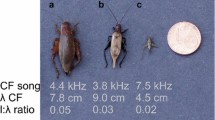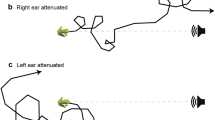Abstract
The ears of lizards are highly directional. The directionality is generated by strong acoustical coupling of the eardrums. A simple lumped-parameter model of the ear followed by binaural comparisons has been shown to perform successful phonotaxis in robot implementations. However, such a model will produce localization errors in the form of response bias if the ears are asymmetrical. We have evaluated how large errors are generated by asymmetry using simulations of the ear model in Mathematica 5.2. The study shows that the effect of asymmetry is minimal around the most directional frequency of the ear, but that biases reduce the useful bandwidth of localization.
Similar content being viewed by others
References
Ho CCK, Narins PM (2006) Directionality of the pressure-difference receiver ears in the northern leopard frog, Rana pipiens pipiens. J Comparative Physiol A 192:341–437
Klump GM (2000) Sound localization in birds. Comparative hearing: birds and reptiles. Springer, New York, pp 249–307
Michelsen A, Popov AV, Lewis B (1994) Physics of directional hearing in the cricket Gryllus bimaculatus. J Comparative Physiol A 175:153–164
Michelsen A (1998) Biophysics of sound localization in insects. Comparative hearing: insects. Springer, New York, pp 18–62
Lund HH, Webb B, Hallam J (1997) A robot attracted to the cricket species Gryllus bimaculatus. Proceedings of the 4th European Conference on Artificial Life, Cambridge, MA, pp 246–255
Webb B, Scutt T (2000) A simple latencydependent spiking neuron model of cricket phonotaxis. Biol Cybernetics 82:247–269
Reeve R, Webb B, Horchler A, et al (2005) New technologies for testing a model of cricket phonotaxis on an outdoor robot. Robotics Auton Syst 51:41–54
Christensen-Dalsgaard J (2005) Directional hearing in nonmammalian tetrapods. Sound source localization. Springer, New York, pp 67–123
Wever EG (1978) The reptile ear: its structure and function. Princeton University Press, Princeton
Zhang L, Hallam J, Christensen-Dalsgaard J (2006) Modelling the peripheral auditory system of lizard. Proceedings of the 9th International Conference on Simulation of Adaptive Behavior (SAB 2006), From Animals to Animates 9, Rome, Italy, September 25–29, 2006, 4095:65–76
Norberg RA (1978) Skull asymmetry, ear structure and function, and auditory localization in Tengmalm’s owl, Aegolius funereus (Linne). Phil Trans R Soc London, Ser B, Biol Sci 282(991): 325–410
Fletcher NH (1992) Acoustic systems in biology. Oxford University Press, Oxford
Christensen-Dalsgaard J, Manley GA (2005) Directionality of the lizard ear. J Exp Biol 208:1209–1277
Author information
Authors and Affiliations
Corresponding author
Additional information
This work was presented in part at the First European Workshop on Artificial Life and Robotics, Vienna, Austria, July 12–13, 2007
About this article
Cite this article
Zhang, L., Hallam, J. & Christensen-Dalsgaard, J. Modelling asymmetry in the peripheral auditory system of the lizard. Artif Life Robotics 13, 5–9 (2008). https://doi.org/10.1007/s10015-008-0504-x
Received:
Accepted:
Published:
Issue Date:
DOI: https://doi.org/10.1007/s10015-008-0504-x




